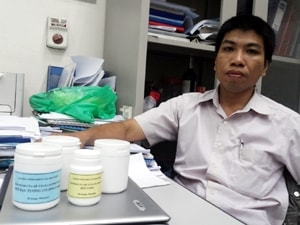Rice bran cures diseases: Success, still in the cupboard
Taking advantage of a raw material that is thought to be only used as feed for livestock and poultry, scientists at the Key Laboratory of Enzyme and Protein Technology (University of Natural Sciences, Vietnam National University, Hanoi) have fermented rice bran extract and applied it as a functional food to regulate some neurological disorders.
Taking advantage of a raw material that is thought to be only used as feed for livestock and poultry, scientists at the Key Laboratory of Enzyme and Protein Technology (University of Natural Sciences, Vietnam National University, Hanoi) have fermented rice bran extract and applied it as a functional food to regulate some neurological disorders.

Dr. Trinh Tat Cuong is still struggling to find an outlet for... rice bran.
(Photo: Trung Hien/Vietnam+)
However, even though it has been accepted by the State Science Council, this highly applicable topic is still… shelved because it has not found an outlet.
Uses from... discarded things
In a small room full of machinery located humbly on the second floor of the University of Natural Sciences, Dr. Trinh Tat Cuong, head of the research team, said that about 15 years ago, he heard a story about a person with nasopharyngeal cancer who ate brown rice for 2 years and is still healthy.
Later, when he had the opportunity to learn, Dr. Cuong found that the most important part of brown rice is the rice membrane, which contains many substances such as protein, amino acids, vitamins, etc., which are beneficial to human health. But in reality, the process of milling to make white rice has removed the rice membrane, creating rice bran, which is also food for livestock and poultry.
According to Dr. Cuong, in many countries around the world, especially Japan, food production often contains GABA (γ-Aminobutyric acid). This is a substance with an important function in the nervous system, regulating some neurological disorders such as Parkinson's, Huntington's, Alzheimer's...
There are currently many methods of producing GABA such as extracting from cereals, creating optimal conditions for rice germination, fermenting soybeans with microorganisms... Among them, the process of producing GABA by fermenting microorganisms (bacteria, fungi) is being widely applied.
Among the traditional foods for GABA production, rice bran is a very abundant source of raw materials because it is only used as feed for livestock and poultry. Therefore, as soon as he received information about the state-level scientific research program for potential young scientists in 2011, Dr. Cuong and his colleagues wrote the topic "Research on the process of producing gamma amino butyric acid from fermented rice bran solution using Lactobacillus for application as functional foods" and was approved for a budget of 970 million VND for research.
After many experiments, young scientists have selected a beneficial bacteria strain Lactobacillus capable of producing GABA from pickled cucumbers, found suitable conditions for the fermentation process, and optimized the ingredients in the rice bran fermentation liquid to produce GABA in powder form by crystallization method.
The results showed that the GABA content obtained was relatively high: about 700 grams of GABA in 10 liters of fermentation liquid. This topic was accepted by the State Science Council and ranked as good.
Still in the "closet"
The production process is simple, raw materials are abundant, and the ability to apply to make cheap functional foods is very high, but up to now, the topic of scientists is still... in the corner of the cupboard.
With a low voice, the young doctor born in 1976 said that with less than 1 billion VND in funding, scientists can only conduct initial research and cannot move on to the trial production stage, even though it has been accepted.
Dr. Cuong said that currently, GABA functional foods to enhance resistance from abroad are imported to Vietnam and sold for about 1 million VND/100 grams, while when producing GABA domestically, the cost will only be about 250,000 VND/100 grams. Meanwhile, the effects will be the same.
According to the calculations of young scientists, to invest in a production line of GABA functional food powder from rice bran is only about 500 million VND. But before that, they need a source of 1 billion VND to continue conducting necessary tests before mass production. However, for them, this amount of money is too much.
Dr. Cuong said he is “struggling” to find an outlet for this research project with very high applicability. However, for each research project to actually be brought to market, it needs the help of businesses, scientists and the government.
According to him, scientists must initially have good works, businesses must see the feasibility, benefits and invest. However, the role of the state in this issue is also very important, especially in supporting clinical trials, having a protection policy for a certain period of time for the inventions of young scientists. Only then can we hope that young scientists will wholeheartedly devote themselves to research, producing topics that are highly applicable to life.
As for their topic, the group of scientists had to… put it in the cupboard and wait for a “miracle” of investment from the state or businesses to continue phase 2, to produce products to serve the people./.
According to (Vietnam+) - VT






